JUC由简入深学习
JUC学习
1.什么是JUC
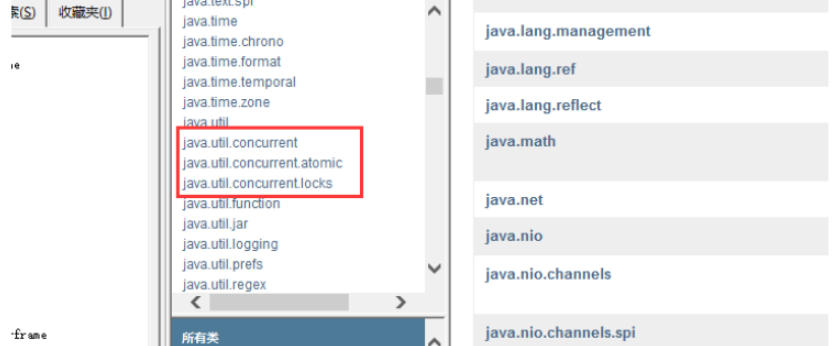
java.util 工具包、包、分类
业务:普通的线程代码 Thread
Runnable 没有返回值、效率相比入 Callable 相对较低!
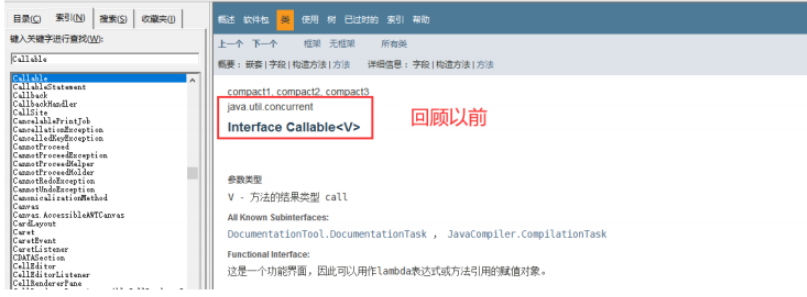

2.线程和进程
线程、进程,如果不能使用一句话说出来的技术,不扎实!
进程:一个程序,QQ.exe Music.exe 程序的集合;
一个进程往往可以包含多个线程,至少包含一个!
Java默认有几个线程? 2 个 mian、GC
线程:开了一个进程 Typora,写字,自动保存(线程负责的)
对于Java而言:Thread、Runnable、Callable
Java 真的可以开启线程吗? 答:开不了
public synchronized void start() {
/**
* This method is not invoked for the main method thread or "system"
* group threads created/set up by the VM. Any new functionality added
* to this method in the future may have to also be added to the VM.
*
* A zero status value corresponds to state "NEW".
*/
if (threadStatus != 0)
throw new IllegalThreadStateException();
/* Notify the group that this thread is about to be started
* so that it can be added to the group"s list of threads
* and the group"s unstarted count can be decremented. */
group.add(this);
boolean started = false;
try {
start0()
started = true;
} finally {
try {
if (!started) {
group.threadStartFailed(this);
}
} catch (Throwable ignore) {
/* do nothing. If start0 threw a Throwable then
it will be passed up the call stack */
}
}
}
// 本地方法,底层的C++ ,Java 无法直接操作硬件
private native void start0();
并发、并行
并发编程:并发、并行
并发(多线程操作同一个资源)
- CPU 一核 ,模拟出来多条线程,天下武功,唯快不破,快速交替
并行(多个人一起行走)
- CPU 多核 ,多个线程可以同时执行; 线程池
public class Test01 {
public static void main(String[] args) {
//获取cpu的核数
// cpu 密集型,IO密集型
System.out.println(Runtime.getRuntime().availableProcessors());
}
}
并发编程的本质:充分利用CPU的资源
线程有几个状态
public enum State {
// 新生
NEW,
// 运行
RUNNABLE,
// 阻塞
BLOCKED,
// 等待,死死地等
WAITING,
// 超时等待
TIMED_WAITING,
// 终止
TERMINATED;
}
wait/sleep 区别
1、来自不同的类
wait => Object
sleep => Thread
2、关于锁的释放
wait 会释放锁,sleep 睡觉了,抱着锁睡觉,不会释放!
3、使用的范围是不同的
wait必须在同步代码块中
sleep可以在任何地方睡
4、是否需要捕获异常
wait 不需要捕获异常
sleep 必须要捕获异常
3.Lock锁(重点)
传统 Synchronized
package com.jihu;
// 基本的卖票例子
/**
* 真正的多线程开发,公司中的开发,降低耦合性
* 线程就是一个单独的资源类,没有任何附属的操作!
* 1、 属性、方法
*/
public class SaleTicketDemo01 {
public static void main(String[] args) {
// 并发:多线程操作同一个资源类, 把资源类丢入线程
Ticket ticket = new Ticket();
// @FunctionalInterface 函数式接口,jdk1.8 lambda表达式 (参数)->{ 代码 }
new Thread(()->{
for (int i = 0; i < 40; i++) {
ticket.sale();
}
},"A").start();
new Thread(()->{
for (int i = 0; i < 40; i++) {
ticket.sale();
}
},"B").start();
new Thread(()->{
for (int i = 0; i < 40; i++) {
ticket.sale();
}
},"C").start();
}
}
//资源类 OOP
class Ticket{
//属性、方法
private int number = 10;
//卖票的方式
//synchronized 本质:队列,锁
public synchronized void sale(){
if (number > 0){
System.out.println(Thread.currentThread().getName()+"卖出了"+(number--)+"票,剩余:"+number);
}
}
}
Lock 接口

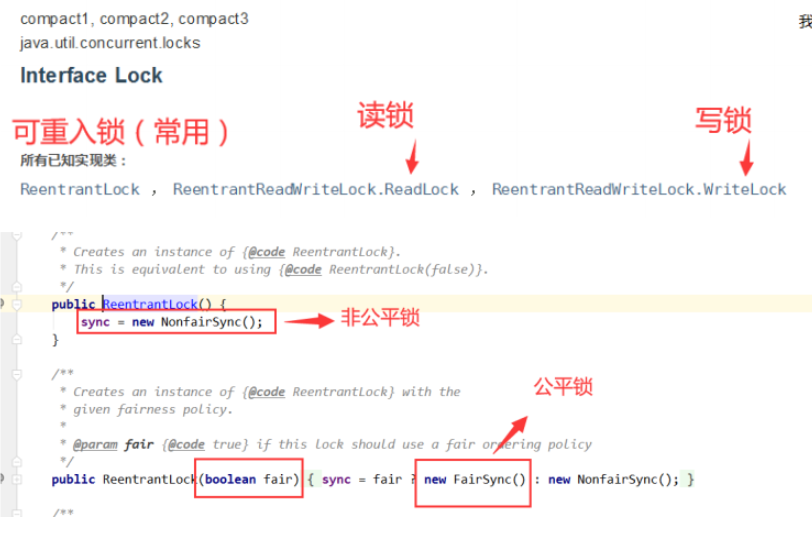
公平锁:十分公平:可以先来后到 非公平锁:
十分不公平:可以插队 (默认)
package com.jihu;
import java.util.concurrent.locks.Lock;
import java.util.concurrent.locks.ReentrantLock;
public class SaleTicketDemo02 {
public static void main(String[] args) {
// 并发:多线程操作同一个资源类, 把资源类丢入线程
Ticket2 ticket = new Ticket2();
new Thread(()->{ for (int i = 0; i < 20; i++) { ticket.sale();}},"A").start();
new Thread(()->{ for (int i = 0; i < 20; i++) { ticket.sale();}},"B").start();
new Thread(()->{ for (int i = 0; i < 20; i++) { ticket.sale();}},"C").start();
}
}
// Lock三部曲
// 1、 new ReentrantLock();
// 2、 lock.lock(); // 加锁
// 3、 finally=> lock.unlock(); // 解锁
class Ticket2{
//属性、方法
private int number = 30;
Lock lock = new ReentrantLock();
public synchronized void sale(){
lock.lock(); //加锁
lock.tryLock(); //加入后不会一直等下去,其他线程阻塞的话
try {
// 业务代码
if (number > 0){
System.out.println(Thread.currentThread().getName()+"卖出了"+(number--)+"票,剩余:"+number);
}
}catch (Exception e){
e.printStackTrace();
}finally {
lock.unlock(); //解锁
}
}
}
Synchronized 和 Lock 区别
1.Synchronized 内置的java关键字,Lock是一个java类
2.Synchronized 无法判断获取锁的状态,Lock可以判断是否获取到了锁
3.Synchronized 会自动释放锁,lock必须手动释放锁,如果不释放锁,会导致死锁
4.Synchronized 线程1(获得锁,阻塞)、线程2(等待,傻傻的等) ; lock锁就不一定会等待下去;
5.Synchronized 可重入锁,不可以中断的,非公平; Lock,可重入锁,可以判断锁,非公平(可以自己设置)
6.Synchronized 适合锁少量的代码同步问题,lock锁适合锁大量的同步代码
4.生产者和消费者问题
面试常考点的:单例模式、排序算法、生产者和消费者、死锁
生产者和消费者问题 Synchronized 版
package com.jihu.productor;
/**
* 线程之间的通信问题:生产者和消费者问题! 等待唤醒,通知唤醒
* 线程交替执行 A B 操作同一个变量 num = 0
* A num+1
* B num-1
*/
public class A {
public static void main(String[] args) {
Date date = new Date();
new Thread(()->{
for (int i = 0; i < 10; i++) {
try {
date.increment();
} catch (InterruptedException e) {
e.printStackTrace();
}
}
},"A").start();
new Thread(()->{
for (int i = 0; i < 10; i++) {
try {
date.decrement();
} catch (InterruptedException e) {
e.printStackTrace();
}
}
},"B").start();
}
}
//可以将生产消费者模式分为 ( 判断等待,业务,通知 ) 三个步骤
class Date{ //数字 资源类
private int number = 0;
//+1
public synchronized void increment() throws InterruptedException {
if (number != 0){
//等待
this.wait();
}
number++;
System.out.println(Thread.currentThread().getName()+"=>"+number);
//通知其他线程,我+1完毕了
this.notify();
}
//-1
public synchronized void decrement() throws InterruptedException {
if (number == 0){
//等待
this.wait();
}
number--;
System.out.println(Thread.currentThread().getName()+"=>"+number);
//通知其他线程,我-1完毕了
this.notify();
}
}
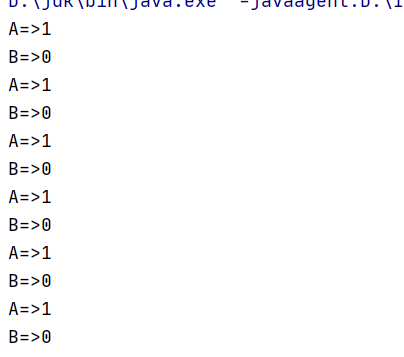
问题存在,A B C D 4 个线程! 虚假唤醒
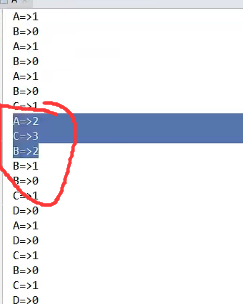
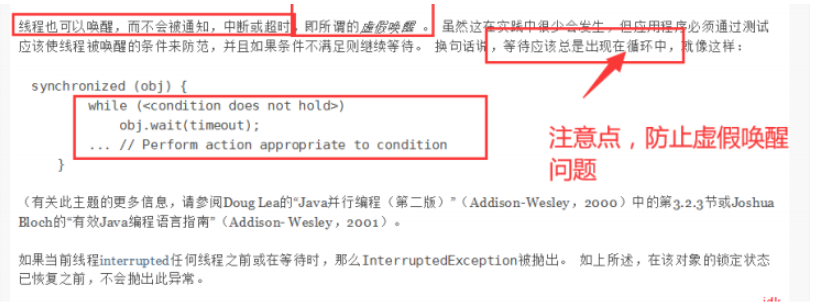
if 改为 while 判断
就可以改变此问题的发生
JUC版的生产者和消费者问题

通过Lock 找到 Condition
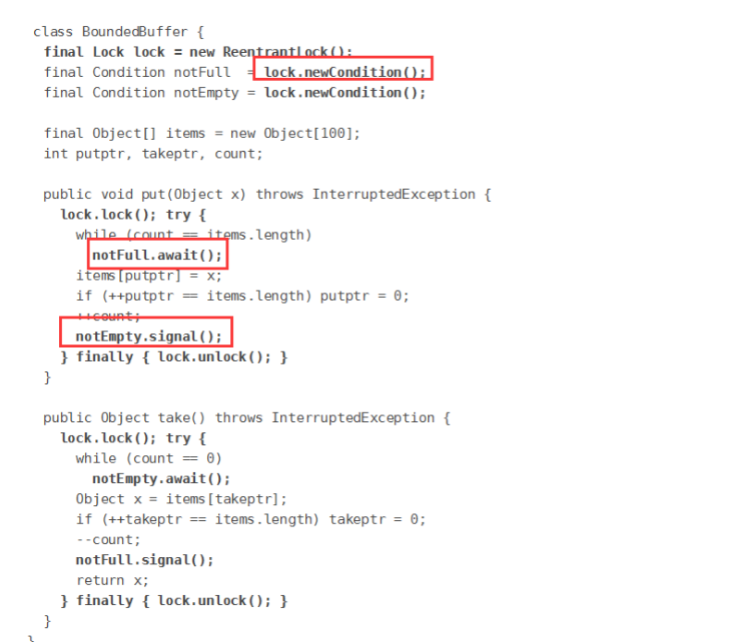
package com.jihu.productor;
import java.util.concurrent.locks.Condition;
import java.util.concurrent.locks.Lock;
import java.util.concurrent.locks.ReentrantLock;
public class B {
public static void main(String[] args) {
Date2 date = new Date2();
new Thread(()->{
for (int i = 0; i < 10; i++) {
try {
date.increment();
} catch (InterruptedException e) {
e.printStackTrace();
}
}
},"A").start();
new Thread(()->{
for (int i = 0; i < 10; i++) {
try {
date.decrement();
} catch (InterruptedException e) {
e.printStackTrace();
}
}
},"B").start();
new Thread(()->{
for (int i = 0; i < 10; i++) {
try {
date.increment();
} catch (InterruptedException e) {
e.printStackTrace();
}
}
},"C").start();
new Thread(()->{
for (int i = 0; i < 10; i++) {
try {
date.decrement();
} catch (InterruptedException e) {
e.printStackTrace();
}
}
},"D").start();
}
}
//可以将生产消费者模式分为 ( 判断等待,业务,通知 ) 三个步骤
class Date2{ //数字 资源类
private int number = 0;
Lock lock = new ReentrantLock();
Condition condition = lock.newCondition();
//+1
public synchronized void increment() throws InterruptedException {
lock.lock(); //上锁
try {
while (number != 0){
//等待
condition.await(); //等待
}
number++;
System.out.println(Thread.currentThread().getName()+"=>"+number);
//通知其他线程,我+1完毕了
condition.signalAll(); //唤醒全部
} catch (InterruptedException e) {
e.printStackTrace();
} finally {
lock.unlock(); //解锁
}
}
//-1
public synchronized void decrement() throws InterruptedException {
lock.lock();
try {
while (number == 0){
//等待
condition.await();
}
number--;
System.out.println(Thread.currentThread().getName()+"=>"+number);
//通知其他线程,我-1完毕了
condition.signalAll();
} catch (InterruptedException e) {
e.printStackTrace();
} finally {
lock.unlock();
}
}
}
任何一个新的技术,绝对不是仅仅只是覆盖了原来的技术,优势和补充!
Condition 精准的通知和唤醒线程
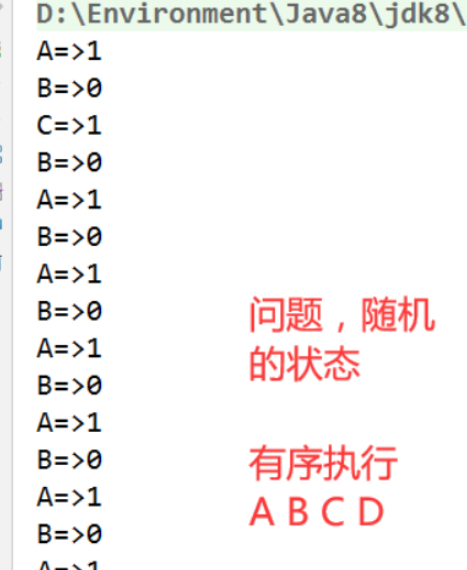
package com.jihu.productor;
import java.util.concurrent.locks.Condition;
import java.util.concurrent.locks.Lock;
import java.util.concurrent.locks.ReentrantLock;
//A 执行完调用B,B执行完调用C,C执行完调用A
public class C {
public static void main(String[] args) {
Data3 data3 = new Data3();
new Thread(()->{
for (int i = 0; i < 10; i++) {
data3.printA();
}
},"A").start();
new Thread(()->{
for (int i = 0; i < 10; i++) {
data3.printB();
}
},"B").start();
new Thread(()->{
for (int i = 0; i < 10; i++) {
data3.printC();
}
},"C").start();
}
}
class Data3{ //资源类 lock
private Lock lock = new ReentrantLock();
Condition condition1 = lock.newCondition();
Condition condition2 = lock.newCondition();
Condition condition3 = lock.newCondition();
private int number = 1; // 1时A执行,2 B执行,3 C执行
public void printA(){
lock.lock();
try {
//业务,判断-> 执行-> 通知
while (number != 1){
//等待
condition1.await();
}
System.out.println(Thread.currentThread().getName()+"=>AAAAAAA");
//唤醒,唤醒指定的人, B
number = 2;
condition2.signal(); //唤醒2
} catch (Exception exception) {
exception.printStackTrace();
} finally {
lock.unlock();
}
}
public void printB(){
lock.lock();
try {
while (number != 2){
condition2.await();
}
System.out.println(Thread.currentThread().getName()+"=>BBBBBBB");
//唤醒 ,唤醒指定的人,C
number = 3;
condition3.signal();
} catch (InterruptedException e) {
e.printStackTrace();
} finally {
lock.unlock();
}
}
public void printC(){
lock.lock();
try {
while (number != 3){
condition3.await();
}
System.out.println(Thread.currentThread().getName()+"=>CCCCCCC");
//唤醒 ,唤醒指定的人,A
number = 1;
condition1.signal();
} catch (InterruptedException e) {
e.printStackTrace();
} finally {
lock.unlock();
}
}
}
测试
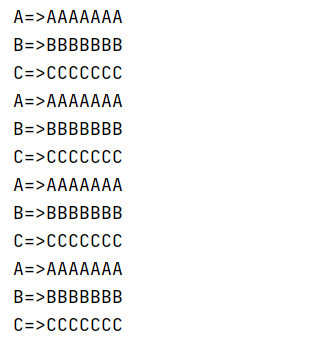
5. 8锁现象
如何判断锁的是谁!永远的知道什么锁,锁到底锁的是谁!
深刻理解我们的锁
测试1
package com.jihu.lock8;
import java.util.concurrent.TimeUnit;
/*
8锁:就是关于锁的8个问题
1、标准情况下,两个线程先打印 发短信还是 打电话? 1/发短信 2/打电话
2、sendSms延迟4秒,两个线程先打印 发短信还是 打电话? 1/发短信 2/打电话
*/
public class Test01 {
public static void main(String[] args) {
Phone phone = new Phone();
new Thread(()->{
phone.sendSms();
},"A").start();
//捕获
try {
TimeUnit.SECONDS.sleep(1);
} catch (InterruptedException e) {
e.printStackTrace();
}
new Thread(()->{
phone.call();
},"B").start();
}
}
class Phone{
//synchronized 锁的对象是方法的调用者
//两个方法用的是同一个锁,谁先拿到谁执行
public synchronized void sendSms() {
// TimeUnit.SECONDS.sleep(4);
System.out.println("发短信");
}
public synchronized void call(){
System.out.println("打电话");
}
}
测试2
package com.jihu.lock8;
import java.util.concurrent.TimeUnit;
/*
3. 增加了一个普通方法后 是先执行发短信还是hello? 答案是: 普通方法
4. 两个对象,两个同步方法,发短信还是 打电话? //打电话
*/
public class Test02 {
public static void main(String[] args) {
//两个对象,两个调用者,两把锁
Phone2 phone = new Phone2();
Phone2 phone2 = new Phone2();
new Thread(()->{
try {
phone.sendSms();
} catch (InterruptedException e) {
e.printStackTrace();
}
},"A").start();
//捕获
try {
TimeUnit.SECONDS.sleep(1);
} catch (InterruptedException e) {
e.printStackTrace();
}
new Thread(()->{
phone2.call();
},"B").start();
}
}
class Phone2{
//synchronized 锁的对象是方法的调用者
public synchronized void sendSms() throws InterruptedException {
TimeUnit.SECONDS.sleep(3);
System.out.println("发短信");
}
public synchronized void call(){
System.out.println("打电话");
}
//这里没有锁,不是同步方法,不受锁的影响
public void hello(){
System.out.println("hello");
}
}
测试3
package com.jihu.lock8;
import java.util.concurrent.TimeUnit;
/*
5. 增加两个静态的同步方法,只有一个对象,是先打印 发短信还是打电话? 答:发短信
6.两个对象! 增加两个静态的同步方法,先打印 发短信还是打电话? 答:发短信
*/
public class Test03 {
public static void main(String[] args) {
//两个对象的Classlei 模板 只有一个 ,static ,锁的是Class
Phone3 phone = new Phone3();
Phone3 phone2 = new Phone3();
new Thread(()->{
try {
phone.sendSms();
} catch (InterruptedException e) {
e.printStackTrace();
}
},"A").start();
//捕获
try {
TimeUnit.SECONDS.sleep(1);
} catch (InterruptedException e) {
e.printStackTrace();
}
new Thread(()->{
// phone.call();
phone2.call();
},"B").start();
}
}
//Phone3唯一的一个Class对象
class Phone3{
//synchronized 锁的对象是方法的调用者
//static 静态方法
//类一加载就有了 锁的是Class
public static synchronized void sendSms() throws InterruptedException {
TimeUnit.SECONDS.sleep(3);
System.out.println("发短信");
}
public static synchronized void call(){
System.out.println("打电话");
}
}
//测试:
发短信
打电话
测试4
package com.jihu.lock8;
import java.util.concurrent.TimeUnit;
/*
7. 1个静态的同步方法,1个普通的同步方法,一个对象,先打印 发短信还是打电话? 答:打电话
8. 1个静态的同步方法,1个普通的同步方法,两个对象,先打印 发短信还是打电话? 答: 打电话
*/
public class Test04 {
public static void main(String[] args) {
//两个对象的Classlei 模板 只有一个 ,static ,锁的是Class
Phone4 phone = new Phone4();
Phone4 phone2 = new Phone4();
new Thread(()->{
try {
phone.sendSms();
} catch (InterruptedException e) {
e.printStackTrace();
}
},"A").start();
//捕获
try {
TimeUnit.SECONDS.sleep(1);
} catch (InterruptedException e) {
e.printStackTrace();
}
new Thread(()->{
// phone.call();
phone2.call();
},"B").start();
}
}
class Phone4{
//静态的同步方法,锁的是Class类模板
public static synchronized void sendSms() throws InterruptedException {
TimeUnit.SECONDS.sleep(3);
System.out.println("发短信");
}
//普通的同步方法 锁的调用者
public synchronized void call(){
System.out.println("打电话");
}
}
//测试:
打电话
发短信
小结
new this 具体的一个手机
static Class 唯一的一个模板
6. 集合类不安全
List 不安全
package com.jihu.unsafe;
import java.util.*;
import java.util.concurrent.CopyOnWriteArrayList;
// java.util.ConcurrentModificationException 并发修改异常!
public class ListTest {
public static void main(String[] args) {
// 并发下 ArrayList 不安全的吗,Synchronized;
/**
* 解决方案:
* 1.List<String> list = new Vector<>();
* 2. List<String> list = Collections.synchronizedList(new ArrayList<>());
* 3.List<String> list = new CopyOnWriteArrayList<>();
*/
//CopyOnWrite 写入时复制, COW 计算机程序设计领域的一种优化策略
//多个线程调用的时候,list,读取的时候,固定的,写入(覆盖)
//在写如的时候避免覆盖,造成数据问题
//读写分离
//CopyOnWriteArrayList比Vector NB在哪里?
// List<String> list = new ArrayList<>(); //会出现ConcurrentModificationException 异常
// List<String> list = new Vector<>();
// List<String> list = Collections.synchronizedList(new ArrayList<>());
List<String> list = new CopyOnWriteArrayList<>();
for (int i = 0; i < 10; i++) {
new Thread(()->{
list.add(UUID.randomUUID().toString().substring(0,5));
System.out.println(list);
},String.valueOf(i)).start();
}
}
/* public static void main(String[] args) {
List<String> list = Arrays.asList("1", "2", "3");
list.forEach(System.out::println);
}*/
}
Set 不安全
package com.jihu.unsafe;
import java.util.Collections;
import java.util.HashSet;
import java.util.Set;
import java.util.UUID;
import java.util.concurrent.CopyOnWriteArraySet;
//同理可证java.util.ConcurrentModificationException 并发修改异常
/*
解决方法:
1.Set<String> set = Collections.synchronizedSet(new HashSet<>());
2. Set<String> set = new CopyOnWriteArraySet<>();
*/
public class SetTest {
public static void main(String[] args) {
// Set<String> set = new HashSet<>(); //会导入出现并发修改异常
// Set<String> set = Collections.synchronizedSet(new HashSet<>());
Set<String> set = new CopyOnWriteArraySet<>();
for (int i = 0; i < 100; i++) {
new Thread(()->{
set.add(UUID.randomUUID().toString().substring(0,5));
System.out.println(set);
},String.valueOf(i)).start();
}
}
}
hashSet 底层是什么?
public HashSet() {
map = new HashMap<>();
}
//add set本质就是map key是无法重复的
public boolean add(E e) {
return map.put(e, PRESENT)==null;
}
private static final Object PRESENT = new Object(); //不变的值
Map 不安全
回顾Map基本操作
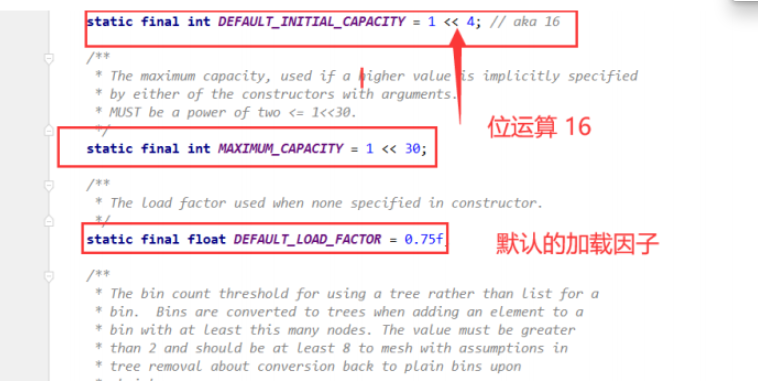
package com.jihu.unsafe;
import java.util.HashMap;
import java.util.Map;
import java.util.UUID;
import java.util.concurrent.ConcurrentHashMap;
//java.util.ConcurrentModificationException 并发修改异常
public class MapTest {
public static void main(String[] args) {
//map是这样用的吗? 不是,工作中不用 HashMap
//默认等价于什么 ? new HashMap<>(16,0.75)
// Map<String, String> map = new HashMap<>(); //出现并发修改异常
//研究ConcurrentHashMap底层原理 在jdk帮助文档中查看
Map<String, String> map = new ConcurrentHashMap<>();
for (int i = 0; i < 100; i++) {
new Thread(()->{
map.put(Thread.currentThread().getName(),UUID.randomUUID().toString().substring(0,5));
System.out.println(map);
},String.valueOf(i)).start();
}
}
}
7.Callable(简单)

1、可以有返回值
2、可以抛出异常
3、方法不同,run()/ call()
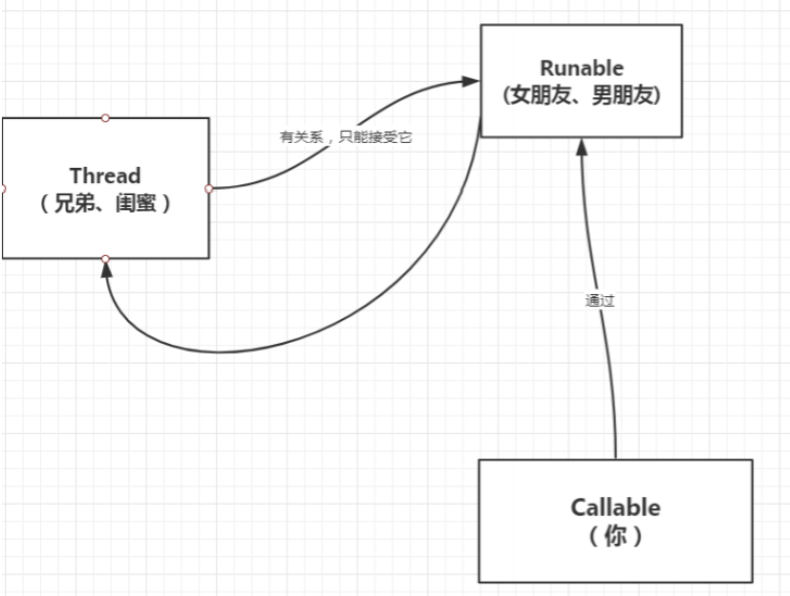

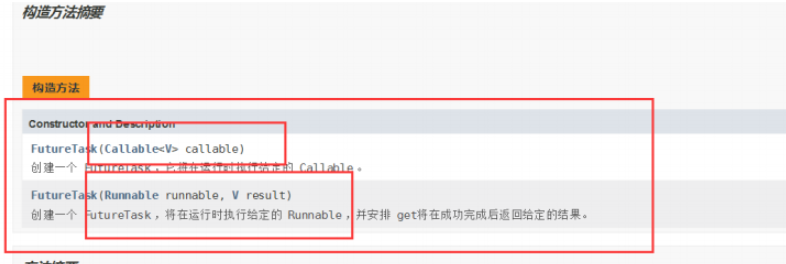
package com.jihu.callable;
import java.util.concurrent.Callable;
import java.util.concurrent.ExecutionException;
import java.util.concurrent.FutureTask;
public class CallableTest {
public static void main(String[] args) throws ExecutionException, InterruptedException {
// new Thread(new Runnable()).start();
// new Thread(new FutureTask()).start();
// new Thread(new FutureTask( Callable )).start();
new Thread().start(); // 怎么启动Callable
MyThread myThread = new MyThread();
FutureTask<Integer> futureTask = new FutureTask<>(myThread); //适配类
new Thread(futureTask,"A").start();
new Thread(futureTask,"B").start(); //就会出现一次call,因为结果会被缓存
Integer o = futureTask.get(); //这个get 方法可能会产生阻塞,把他放到最后,或者使用异步通信来处理
System.out.println(o);
}
}
class MyThread implements Callable<Integer>{
@Override
public Integer call() throws Exception {
System.out.println("call");
return 1024;
}
}
//展示结果
call
1024
细节:
1、有缓存
2、结果可能需要等待,会阻塞!
8.常用的辅助类(必会)
8.1 CountDownLatch
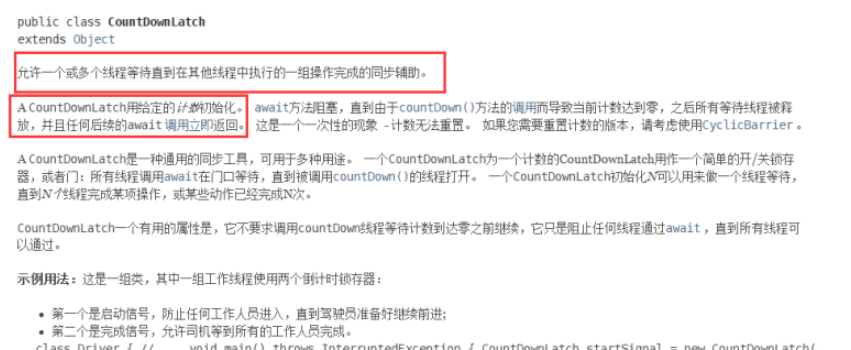
//CountDownLatch 相当于减法计数器
package com.jihu.add;
import java.util.concurrent.CountDownLatch;
//计数器
public class CountDownLatchDemo {
public static void main(String[] args) throws InterruptedException {
//总数是6 , 在一些必须要执行任务的时候再使用。
CountDownLatch countDownLatch = new CountDownLatch(6);
for (int i = 0; i < 6; i++) {
new Thread(()->{
System.out.println(Thread.currentThread().getName()+" go out");
countDownLatch.countDown(); //数量-1
},String.valueOf(i)).start();
}
countDownLatch.await(); //等待计数器归零, 然后再向下执行
System.out.println("close door");
}
}
//测试结果
0 go out
1 go out
4 go out
3 go out
5 go out
2 go out
close door
原理:
countDownLatch.countDown();// 数量-1
countDownLatch.await(); // 等待计数器归零,然后再向下执行
每次有线程调用 countDown() 数量-1,假设计数器变为0,countDownLatch.await() 就会被唤醒,继续 执行!
8.2 CyclicBarrier

//CyclicBarrier 想当于加法计数器
package com.jihu.add;
import java.util.concurrent.BrokenBarrierException;
import java.util.concurrent.CyclicBarrier;
public class CyclicBarrierDemo {
public static void main(String[] args) {
CyclicBarrier cyclicBarrier = new CyclicBarrier(7,()->{
System.out.println("集齐7颗龙珠,召唤神龙");
});
for (int i = 1; i <= 7; i++) {
final int temp = i; //在lambda中不能直接使用本地i,作用域不同,所以需要转为final类型
new Thread(()->{
System.out.println(Thread.currentThread().getName()+"收集了"+temp+"颗龙珠");
try {
cyclicBarrier.await(); //没收集7颗龙珠则等待
} catch (InterruptedException e) {
e.printStackTrace();
} catch (BrokenBarrierException e) {
e.printStackTrace();
}
}).start();
}
}
}
//测试
Thread-5收集了6颗龙珠
Thread-1收集了2颗龙珠
Thread-3收集了4颗龙珠
Thread-6收集了7颗龙珠
Thread-4收集了5颗龙珠
Thread-2收集了3颗龙珠
Thread-0收集了1颗龙珠
集齐7颗龙珠,召唤神龙
8.3 Semaphore
Semaphore:信号量

抢车位!
6车—3个停车位置
package com.jihu.add;
import java.util.concurrent.Semaphore;
import java.util.concurrent.TimeUnit;
public class SemaphoreDemo {
public static void main(String[] args) {
//线程数量: 停车位 , 限流中都会用到
Semaphore semaphore = new Semaphore(3);
for (int i = 0; i < 6; i++) {
new Thread(()->{
try {
//acquire 得到
semaphore.acquire(); //得到
System.out.println(Thread.currentThread().getName()+" 抢到了车位");
TimeUnit.SECONDS.sleep(3);
System.out.println(Thread.currentThread().getName()+" 离开了车位");
} catch (InterruptedException e) {
e.printStackTrace();
}finally {
//release(); 释放
semaphore.release(); // 释放车位
}
},String.valueOf(i)).start();
}
}
}
//测试结果
1 抢到了车位
5 抢到了车位
0 抢到了车位
1 离开了车位
5 离开了车位
0 离开了车位
2 抢到了车位
3 抢到了车位
4 抢到了车位
2 离开了车位
3 离开了车位
4 离开了车位
原理:
semaphore.acquire() 获得,假设如果已经满了,等待,等待被释放为止!
semaphore.release(); 释放,会将当前的信号量释放 + 1,然后唤醒等待的线程!
作用: 多个共享资源互斥的使用!并发限流,控制最大的线程数!
9.读写锁

package com.jihu.rw;
import java.util.HashMap;
import java.util.Map;
import java.util.concurrent.locks.ReadWriteLock;
import java.util.concurrent.locks.ReentrantReadWriteLock;
/**
* 独占锁(写锁) 一次只能被一个线程占有
* 共享锁(读锁) 多个线程可以同时占有
* ReadWriteLock
* 读-读 可以共存!
* 读-写 不能共存!
* 写-写 不能共存!
*/
public class ReadWriteLockDemo {
public static void main(String[] args) {
// MyCache myCache = new MyCache();
MyCacheLock myCache = new MyCacheLock();
//写入
for (int i = 0; i < 5; i++) {
final int temp = i;
new Thread(()->{
myCache.put(temp+"",temp+"");
},String.valueOf(temp)).start();
}
//读取
for (int i = 0; i < 5; i++) {
final int temp = i;
new Thread(()->{
myCache.get(temp+"");
},String.valueOf(temp)).start();
}
}
}
//加锁的
class MyCacheLock{
private volatile Map<String,Object> map = new HashMap<>();
//读写锁, 更加细粒度的控制
private ReadWriteLock readWriteLock = new ReentrantReadWriteLock();
//存,写入的时候,只希望同时只有一个线程写
public void put(String key,Object value){
readWriteLock.writeLock().lock();//写加锁
try {
System.out.println(Thread.currentThread().getName()+"写入"+key);
map.put(key,value);
System.out.println(Thread.currentThread().getName()+"写入OK");
} catch (Exception exception) {
exception.printStackTrace();
} finally {
readWriteLock.writeLock().unlock(); //写解锁
}
}
//取 ,读时 所有人都可以读
public void get(String key){
readWriteLock.readLock().lock(); //读加锁
try {
System.out.println(Thread.currentThread().getName()+"读取"+key);
Object o = map.get(key);
System.out.println(Thread.currentThread().getName()+"读取OK");
} catch (Exception exception) {
exception.printStackTrace();
} finally {
readWriteLock.readLock().unlock(); //读解锁
}
}
}
//测试结果
/* 4写入4
4写入OK
3写入3
3写入OK
0读取0
0读取OK
1读取1
1读取OK*/
//自定义缓存
class MyCache{
private volatile Map<String,Object> map = new HashMap<>();
// 存,写
public void put(String key,Object value){
System.out.println(Thread.currentThread().getName()+"写入"+key);
map.put(key,value);
System.out.println(Thread.currentThread().getName()+"写入OK");
}
// 取,读
public void get(String key){
System.out.println(Thread.currentThread().getName()+"读取"+key);
Object o = map.get(key);
System.out.println(Thread.currentThread().getName()+"读取OK");
}
}
//出现的问题
/* 9写入9
7读取7
6写入6
3写入3
4读取4
0读取0
8读取8
8写入8*/
10.阻塞队列

阻塞队列:

BlockingQueue BlockingQueue 不是新的东西

什么情况下我们会使用 阻塞队列:多线程并发处理,线程池!
学会使用队列
添加、移除
四组API(重要)
| 方式 | 抛出异常 | 有返回值,不抛出异常 | 阻塞 等待 | 超时等待 |
|---|---|---|---|---|
| 添加 | add | offer() | put() | offer(..) |
| 移除 | remove | poll() | take() | poll(..) |
| 检测队首元素 | element | peak() | – | – |
public static void main(String[] args) throws InterruptedException {
// test1();
// test2();
// test3();
test4();
}
/*
抛出异常
*/
public static void test1(){
//队列的大小
ArrayBlockingQueue<Object> blockingQueue = new ArrayBlockingQueue<>(3);
System.out.println(blockingQueue.add("a"));
System.out.println(blockingQueue.add("b"));
System.out.println(blockingQueue.add("c"));
System.out.println(blockingQueue.element()); //查看队首元素是谁
//java.lang.IllegalStateException: Queue full 跑出异常
// System.out.println(blockingQueue.add("d"));
System.out.println("--------------");
System.out.println(blockingQueue.remove());
System.out.println(blockingQueue.remove());
System.out.println(blockingQueue.remove());
//java.util.NoSuchElementException 抛出异常
// System.out.println(blockingQueue.remove());
}
/*
有返回值,不抛出异常
*/
public static void test2(){
ArrayBlockingQueue blockingQueue = new ArrayBlockingQueue<>(3);
System.out.println(blockingQueue.offer("a2"));
System.out.println(blockingQueue.offer("b2"));
System.out.println(blockingQueue.offer("c2"));
System.out.println(blockingQueue.peek()); //检查队首元素
//blockingQueue.offer("d2") 返回false 不抛出异常
System.out.println(blockingQueue.offer("d2"));
System.out.println("--------------");
System.out.println(blockingQueue.poll());
System.out.println(blockingQueue.poll());
System.out.println(blockingQueue.poll());
//不会抛出异常 返回 null
System.out.println(blockingQueue.poll());
}
/*
阻塞 等待(一直阻塞)
*/
public static void test3() throws InterruptedException {
ArrayBlockingQueue blockingQueue = new ArrayBlockingQueue<>(3);
//一直阻塞
blockingQueue.put("a");
blockingQueue.put("b");
blockingQueue.put("c");
// blockingQueue.put("d"); //队列没有位置了,就会一直阻塞
System.out.println(blockingQueue.take());
System.out.println(blockingQueue.take());
System.out.println(blockingQueue.take());
// System.out.println(blockingQueue.take()); //没有这个元素后,就会一直阻塞
}
/*
阻塞 等待(等待超时)
*/
public static void test4() throws InterruptedException {
ArrayBlockingQueue blockingQueue = new ArrayBlockingQueue<>(3);
blockingQueue.offer("a");
blockingQueue.offer("b");
blockingQueue.offer("c");
// blockingQueue.offer("d",2, TimeUnit.SECONDS); //等待2秒 超时后就会退出
System.out.println("------------");
System.out.println(blockingQueue.poll());
System.out.println(blockingQueue.poll());
System.out.println(blockingQueue.poll());
blockingQueue.poll(2,TimeUnit.SECONDS); //等待超时2秒后就退出
}
SynchronousQueue 同步队列
没有容量,
进去一个元素,必须等待取出来之后,才能再往里面放一个元素!
put、take
package com.jihu.bq;
import java.util.concurrent.BlockingQueue;
import java.util.concurrent.SynchronousQueue;
import java.util.concurrent.TimeUnit;
/**
* 同步队列
* 和其他的BlockingQueue 不一样, SynchronousQueue 不存储元素
* put了一个元素,必须从里面先take取出来,否则不能在put进去值!
*/
public class SynchronousQueueDemo {
public static void main(String[] args) {
// SynchronousQueue<Object> objects = new SynchronousQueue<>();//同步队列
BlockingQueue blockingQueue = new SynchronousQueue<>();//同步队列
new Thread(()->{
try {
System.out.println(Thread.currentThread().getName()+" put 1");
blockingQueue.put(1);
System.out.println(Thread.currentThread().getName()+" put 2");
blockingQueue.put(2);
System.out.println(Thread.currentThread().getName()+" put 3");
blockingQueue.put(3);
} catch (InterruptedException e) {
e.printStackTrace();
}
},"T1").start();
new Thread(()->{
try {
TimeUnit.SECONDS.sleep(2);
System.out.println(Thread.currentThread().getName()+"=>"+blockingQueue.take());
TimeUnit.SECONDS.sleep(2);
System.out.println(Thread.currentThread().getName()+"=>"+blockingQueue.take());
TimeUnit.SECONDS.sleep(2);
System.out.println(Thread.currentThread().getName()+"=>"+blockingQueue.take());
} catch (InterruptedException e) {
e.printStackTrace();
}
},"T2").start();
}
}
//测试
T1 put 1
T1 put 2
T2=>1
T1 put 3
T2=>2
T2=>3
11. 线程池(重点)
线程池:三大方法、7大参数、4种拒绝策略
池化技术
程序的运行,本质:占用系统的资源! 优化资源的使用!=>池化技术
线程池、连接池、内存池、对象池///….. 创建、销毁。十分浪费资源
池化技术:事先准备好一些资源,有人要用,就来我这里拿,用完之后还给我。
线程池的好处:
1、降低资源的消耗
2、提高响应的速度
3、方便管理。
线程复用、可以控制最大并发数、管理线程
1.三大方法
线程池:三大方法

package com.jihu.bq;
import java.util.concurrent.ExecutorService;
import java.util.concurrent.Executors;
// Executors 工具类、3大方法
public class Demo01 {
public static void main(String[] args) {
// ExecutorService threadPool = Executors.newSingleThreadExecutor(); //单个线程
ExecutorService threadPool = Executors.newFixedThreadPool(5); //创建一个固定的线程池的大小
// ExecutorService threadPool = Executors.newCachedThreadPool(); // 可伸缩的,遇强则强,遇弱则弱
try {
for (int i = 0; i < 10; i++) {
//使用了线程池之后,使用线程池来创建线程
threadPool.execute(()->{
System.out.println(Thread.currentThread().getName()+" ok");
});
}
} catch (Exception exception) {
exception.printStackTrace();
} finally {
// 线程池用完,程序结束,关闭线程池
threadPool.shutdown();
}
}
}
newSingleThreadExecutor测试结果:

newFixedThreadPool(5)测试结果:

newCachedThreadPool测试结果:

2、7大参数
7大参数
源码分析
public static ExecutorService newSingleThreadExecutor() {
return new FinalizableDelegatedExecutorService
(new ThreadPoolExecutor(1, 1,
0L, TimeUnit.MILLISECONDS,
new LinkedBlockingQueue()));
}
public static ExecutorService newFixedThreadPool(int nThreads) {
return new ThreadPoolExecutor(5, 5,
0L, TimeUnit.MILLISECONDS,
new LinkedBlockingQueue());
}
public static ExecutorService newCachedThreadPool() {
return new ThreadPoolExecutor(0, Integer.MAX_VALUE,
60L, TimeUnit.SECONDS,
new SynchronousQueue());
}
// 本质ThreadPoolExecutor()
public ThreadPoolExecutor(int corePoolSize, // 核心线程池大小
int maximumPoolSize, // 最大核心线程池大小
long keepAliveTime,// 超时了没有人调用就会释放
TimeUnit unit, //超时单位
BlockingQueue<Runnable> workQueue, //阻塞队列
ThreadFactory threadFactory, //线程工厂:创建线程的,一般不用动。
RejectedExecutionHandler handler //拒绝策略) {
if (corePoolSize < 0 ||
maximumPoolSize <= 0 ||
maximumPoolSize < corePoolSize ||
keepAliveTime < 0)
throw new IllegalArgumentException();
if (workQueue == null || threadFactory == null || handler == null)
throw new NullPointerException();
this.corePoolSize = corePoolSize;
this.maximumPoolSize = maximumPoolSize;
this.workQueue = workQueue;
this.keepAliveTime = unit.toNanos(keepAliveTime);
this.threadFactory = threadFactory;
this.handler = handler;
}


手动创建一个线程池
package com.jihu.bq02;
import java.util.concurrent.*;
/**
* new ThreadPoolExecutor.AbortPolicy() //银行满了,还有人进来,不处理这个人的,抛出异常
* new ThreadPoolExecutor.CallerRunsPolicy() //哪来的去哪里 main来的就main方法执行
* new ThreadPoolExecutor.DiscardPolicy() //队列满了,丢掉任务,不会抛出异常
* new ThreadPoolExecutor.DiscardOldestPolicy() //队列满了,尝试去和最早的竞争,如果最早的快要结束了就可能等会,要不然就会离开,不会抛出异常
*/
public class Demo02 {
public static void main(String[] args) {
//自定义线程池! 工作工需要自己自定义
ExecutorService threadPool = new ThreadPoolExecutor(
2,
5,
3,
TimeUnit.SECONDS,
new LinkedBlockingDeque<>(3),
Executors.defaultThreadFactory(),
new ThreadPoolExecutor.DiscardOldestPolicy()); //队列满了,尝试去和最早的竞争,如果最早的快要结束了就可能等会,要不然就会离开,不会抛出异常
try {
// 最大承载:Deque + max
// 超过 最大承载后 抛出: java.util.concurrent.RejectedExecutionException
for (int i = 0; i < 9; i++) {
// 使用了线程池之后,使用线程池来创建线程
threadPool.execute(()->{
System.out.println(Thread.currentThread().getName()+" ok");
});
}
}catch (Exception e){
e.printStackTrace();
}finally {
threadPool.shutdown();// 线程池用完,程序结束,关闭线程池
}
}
}
3、四种拒绝策略
四种拒绝策略
/**
* new ThreadPoolExecutor.AbortPolicy() //银行满了,还有人进来,不处理这个人的,抛出异常
* new ThreadPoolExecutor.CallerRunsPolicy() //哪来的去哪里 main来的就main方法执行
* new ThreadPoolExecutor.DiscardPolicy() //队列满了,丢掉任务,不会抛出异常
* new ThreadPoolExecutor.DiscardOldestPolicy() //队列满了,尝试去和最早的竞争,如果最早的快要结束了就可能等会,要不然就会离开,不会抛出异常
*/
小结和拓展
池的最大的大小如何去设置!(下面代码即是)
了解:IO密集型,CPU密集型:(调优用到的)
package com.jihu.bq02;
import java.util.concurrent.*;
public class Demo02 {
public static void main(String[] args) {
//自定义线程池! 工作工需要自己自定义
// 最大线程到底该如何定义
// 1、CPU 密集型,几核,就是几,可以保持CPU的效率最高!
// 2、IO 密集型 > 判断你程序中十分耗IO的线程,
// 程序 15个大型任务 IO十分占用资源!(io密集型要定义大于15才行,才有其他的线程去执行别的任务)
// 获取CPU的核数
System.out.println(Runtime.getRuntime().availableProcessors());
ExecutorService threadPool = new ThreadPoolExecutor(
2,
5,
3,
TimeUnit.SECONDS,
new LinkedBlockingDeque<>(3),
Executors.defaultThreadFactory(),
new ThreadPoolExecutor.DiscardOldestPolicy()); //队列满了,尝试去和最早的竞争,如果最早的快要结束了就可能等会,要不然就会离开,不会抛出异常
try {
// 最大承载:Deque + max
// 超过 最大承载后 抛出: java.util.concurrent.RejectedExecutionException
for (int i = 0; i < 9; i++) {
// 使用了线程池之后,使用线程池来创建线程
threadPool.execute(()->{
System.out.println(Thread.currentThread().getName()+" ok");
});
}
}catch (Exception e){
e.printStackTrace();
}finally {
threadPool.shutdown();// 线程池用完,程序结束,关闭线程池
}
}
}
12、四大函数式接口(必需掌握)
新时代的程序员必会:lambda表达式、链式编程、函数式接口、Stream流式计算
函数式接口: 只有一个方法的接口
@FunctionalInterface
public interface Runnable {
public abstract void run();
}
//超多 @FunctionalInterface
//简化编程模型,在新版本的框架底层大量应用
//foreach(消费者类的函数式接口)
//
Function函数式接口
代码测试
package com.jihu.function;
import java.util.function.Function;
/*
* Function 函数型接口, 有一个输入参数,有一个输出
* 只要是 函数型接口 可以 用 lambda表达式简化
*/
public class Demofunction01 {
public static void main(String[] args) {
// Function<String, String> function = new Function<>(){
//
// @Override
// public String apply(String str) {
// return str;
// }
// };
//(str) 为传入的参数
//{return str;} 里面为具体的代码
Function<String, String> function =(str)->{return str;}; //lambada表达式对上面式子的简化
System.out.println(function.apply("aaa1"));
}
}
断定型接口:有一个输入参数,返回值只能是 布尔值!
package com.jihu.function;
import java.util.function.Predicate;
/*
断定型接口:有一个输入参数,返回值只能是 布尔值!
*/
public class Demofunction02 {
public static void main(String[] args) {
//判断字符串是否为空
/* Predicate<String> predicate = new Predicate<>(){
@Override
public boolean test(String str) {
return str.isEmpty();
}
};*/
Predicate<String> predicate =(str)->{return str.isEmpty();};
System.out.println(predicate.test("1as")); //返回false
// System.out.println(predicate.test("")); //返回true
}
}
Consumer 消费型接口
package com.jihu.function;
import java.util.function.Consumer;
/**
* Consumer 消费型接口: 只有输入,没有返回值
*/
public class Demofunction03 {
public static void main(String[] args) {
/* Consumer<String> consumer = new Consumer<>() {
@Override
public void accept(String str) {
System.out.println(str);
}
};*/
Consumer<String> consumer =(str)->{
System.out.println(str);
};
consumer.accept("asad");
}
}
Supplier 供给型接口
package com.jihu.function;
import java.util.function.Supplier;
/**
* Supplier 供给型接口 没有参数,只有返回值
*/
public class Demofunction04 {
public static void main(String[] args) {
/*Supplier<String> supplier = new Supplier<>(){
@Override
public String get() {
return "stras";
}
};*/
Supplier<String> supplier =()->{return "adas";};
System.out.println(supplier.get());
}
}
13、Stream流式运算
什么是Stream流式运算
大数据:存储 + 计算
集合、MySQL 本质就是存储东西的;
计算都应该交给流来操作!
@Data
@NoArgsConstructor
@AllArgsConstructor
public class User {
private Integer id;
private String name;
private Integer age;
}
package com.jihu.stream;
import java.util.Arrays;
import java.util.List;
/**
* 题目要求:一分钟内完成此题,只能用一行代码实现!
* 现在有5个用户!筛选:
* 1、ID 必须是偶数
* 2、年龄必须大于23岁
* 3、用户名转为大写字母
* 4、用户名字母倒着排序
* 5、只输出一个用户!
*/
public class Trst {
public static void main(String[] args) {
User u1 = new User(1, "a", 21);
User u2 = new User(2, "b", 22);
User u3 = new User(3, "c", 23);
User u4 = new User(4, "d", 24);
User u5 = new User(5, "e", 25);
User u6 = new User(6, "f", 26);
//集合就是存储 把上述user存入集合中
List<User> list = Arrays.asList(u1, u2, u3, u4, u5,u6);
//计算交给stream流
// lambda表达式、下面叫 链式编程、函数式接口、Stream流式计算
list.stream()
.filter(u->{return u.getId()%2==0;}) //ID 必须是偶数
.filter(u->{return u.getAge()>23;}) //年龄必须大于23岁
.map(u->{return u.getName().toUpperCase();}) //用户名转为大写字母 D F
.sorted((uu1,uu2)->{return uu2.compareTo(uu1);}) // 用户名字母倒着排序 F D
.limit(1) // 只输出一个用户! F
.forEach(System.out::println);
}
}
14、ForkJoin
什么是 ForkJoin
ForkJoin 在 JDK 1.7 , 并行执行任务!提高效率。大数据量 才使用它!
大数据:Map Reduce (把大任务拆分为小任务)
ForkJoin 特点:工作窃取
这个里面维护的都是双端队列(B执行完后开始执行A的任务,这叫工作窃取,但可能会出现同时都抢一个资源的现象。)
ForkJoin
package com.jihu.forkjoin;
import java.util.concurrent.ForkJoinTask;
import java.util.concurrent.RecursiveTask;
/**
* 求和计算的任务!
* 3000 6000(ForkJoin) 9000(Stream并行流)
* // 如何使用 forkjoin
* // 1、forkjoinPool 通过它来执行
* // 2、计算任务 forkjoinPool.execute(ForkJoinTask task)
* // 3. 计算类要继承 ForkJoinTask
*/
public class ForkJoinDemo extends RecursiveTask<Long> {
private Long start;
private Long end;
//临界值
private Long temp = 10000L;
public ForkJoinDemo(Long start, Long end) {
this.start = start;
this.end = end;
}
//计算方法
@Override
protected Long compute() {
if ((end-start) < temp){
Long sum = 0L;
for (Long i=start;i<=end;i++){
sum+=i;
}
return sum;
}else { //forkjoin 递归
long middle = (end+start)/2; //中间值
ForkJoinDemo task1 = new ForkJoinDemo(start, middle);
task1.fork(); //拆分任务,把任务压入线程队列
ForkJoinDemo task2 = new ForkJoinDemo(middle + 1, end);
task2.fork();//拆分任务,把任务压入线程队列
return task1.join()+task2.join();
}
}
}
测试
package com.jihu.forkjoin;
public class Test {
public static void main(String[] args) throws ExecutionException, InterruptedException {
// test1(); //11583
// test2(); //9751
test3(); //899
}
// 普通程序员
public static void test1(){
Long sum = 0L;
long start = System.currentTimeMillis();
for (Long i = 1L; i <10_0000_0000 ; i++) {
sum+=i;
}
long end = System.currentTimeMillis();
System.out.println("sum="+sum+"时间:"+(end-start));
}
// 会使用ForkJoin
public static void test2() throws ExecutionException, InterruptedException {
long start = System.currentTimeMillis();
ForkJoinPool forkJoinPool = new ForkJoinPool();
ForkJoinTask task = new ForkJoinDemo(0L,10_0000_0000L);
ForkJoinTask submit = forkJoinPool.submit(task); //提交任务
Long sum = (Long) submit.get();
long end = System.currentTimeMillis();
System.out.println("sum="+sum+"时间:"+(end-start));
}
public static void test3(){
long start = System.currentTimeMillis();
//Stream并行流 parallel:表示并行
long sum = LongStream.rangeClosed(0L, 10_0000_0000L).parallel().reduce(0, Long::sum);
long end = System.currentTimeMillis();
System.out.println("sum="+sum+"时间:"+(end-start));
}
}
15、异步回调
Future 设计的初衷: 对将来的某个事件的结果进行建模
package com.jihu.future;
import java.util.concurrent.CompletableFuture;
import java.util.concurrent.ExecutionException;
import java.util.concurrent.TimeUnit;
/**
* 异步调用: CompletableFuture
* // 异步执行
* // 成功回调
* // 失败回调
*/
public class Demo01 {
public static void main(String[] args) throws ExecutionException, InterruptedException {
//没有返回值的 runAsync 异步回调
//Void跟void不同,Void是包装类,和Integer类似
/* CompletableFuture<Void> completableFuture = CompletableFuture.runAsync(() -> {
try {
TimeUnit.SECONDS.sleep(2);
} catch (InterruptedException e) {
e.printStackTrace();
}
System.out.println(Thread.currentThread().getName()+"runAsync=>Void");
});
System.out.println("1111");
completableFuture.get(); // 获取阻塞执行结果 */
//输出结果为
// 1111
// ForkJoinPool.commonPool-worker-3runAsync=>Void
//有返回值的 supplyAsync 异步回调
// ajax,成功和失败的回调
// 返回的是错误信息;
CompletableFuture<Integer> completableFuture = CompletableFuture.supplyAsync(() -> {
System.out.println(Thread.currentThread().getName()+"supplyAsync => Integer");
int i= 10/0;
return 1024;
});
System.out.println(completableFuture.whenComplete((t,u)->{
System.out.println("t=>"+t); //正常的返回结果
System.out.println("u=>"+u); //错误信息 :java.util.concurrent.CompletionException: java.lang.ArithmeticException: / by zero
}).exceptionally((e)->{
System.out.println(e.getMessage());
return 233; // 可以获取到错误的返回结果
}).get());
//输出结果为 正常的话
/*ForkJoinPool.commonPool-worker-3supplyAsync => Integer
t=>1024
u=>null
1024*/
//输出结果为 不正常的话
/*ForkJoinPool.commonPool-worker-3supplyAsync => Integer
t=>null
u=>java.util.concurrent.CompletionException: java.lang.ArithmeticException: / by zero
java.lang.ArithmeticException: / by zero
233*/
}
}
16、JMM
请你谈谈你对 Volatile 的理解
Volatile 是 Java 虚拟机提供轻量级的同步机制
1、保证可见性
2、不保证原子性
3、禁止指令重排
什么是JMM
JMM : Java内存模型,不存在的东西,概念!约定!
关于JMM的一些同步的约定:
1、线程解锁前,必须把共享变量立刻刷回主存。
2、线程加锁前,必须读取主存中的最新值到工作内存中!
3、加锁和解锁是同一把锁
线程 工作内存 、主内存
8种操作:
内存交互操作有8种,虚拟机实现必须保证每一个操作都是原子的,不可在分的(对于double和long类 型的变量来说,load、store、read和write操作在某些平台上允许例外)
- lock (锁定):作用于主内存的变量,把一个变量标识为线程独占状态
- unlock (解锁):作用于主内存的变量,它把一个处于锁定状态的变量释放出来,释放后的变量才可以被其他线程锁定
- read (读取):作用于主内存变量,它把一个变量的值从主内存传输到线程的工作内存中,以便随后的load动作使用
- load (载入):作用于工作内存的变量,它把read操作从主存中变量放入工作内存中
- use (使用):作用于工作内存中的变量,它把工作内存中的变量传输给执行引擎,每当虚拟机遇到一个需要使用到变量的值,就会使用到这个指令
- assign (赋值):作用于工作内存中的变量,它把一个从执行引擎中接受到的值放入工作内存的变量副本中
- store (存储):作用于主内存中的变量,它把一个从工作内存中一个变量的值传送到主内存中,以便后续的write使用
- write (写入):作用于主内存中的变量,它把store操作从工作内存中得到的变量的值放入主内存的变量中
JMM对这八种指令的使用,制定了如下规则:
- 不允许read和load、store和write操作之一单独出现。即使用了read必须load,使用了store必须write
- 不允许线程丢弃他最近的assign操作,即工作变量的数据改变了之后,必须告知主存
- 不允许一个线程将没有assign的数据从工作内存同步回主内存
- 一个新的变量必须在主内存中诞生,不允许工作内存直接使用一个未被初始化的变量。就是怼变量实施use、store操作之前,必须经过assign和load操作
- 一个变量同一时间只有一个线程能对其进行lock。多次lock后,必须执行相同次数的unlock才能解锁
- 如果对一个变量进行lock操作,会清空所有工作内存中此变量的值,在执行引擎使用这个变量前,必须重新load或assign操作初始化变量的值
- 如果一个变量没有被lock,就不能对其进行unlock操作。也不能unlock一个被其他线程锁住的变量对一个变量进行unlock操作之前,必须把此变量同步回主内存
问题: 程序不知道主内存的值已经被修改过了
17、Volatile
1.保证可见性
1、保证可见性
package com.jihu.volatilet;
import java.util.concurrent.TimeUnit;
public class JMMDemo {
//不加 volatile 程序就会出现死循环。 (没有可见性)
//加了 volatile 可以保证可见性
private volatile static int num = 0;
public static void main(String[] args) {
new Thread(()->{ //线程 1 对主内存的变化是不知道的
while (num==0){
}
}).start();
try {
TimeUnit.SECONDS.sleep(1);
} catch (InterruptedException e) {
e.printStackTrace();
}
num = 1;
System.out.println(num);
}
}
//输出结果
1
2.不保证原子性
2、不保证原子性
package com.jihu.volatilet;
public class VDemo02 {
// volatile 不保证原子性
private volatile static int num = 0;
public static void add(){
num++;
}
public static void main(String[] args) {
//理论上num结果应该为 2 万
for (int i = 0; i < 20; i++) {
new Thread(()->{
for (int i1 = 0; i1 < 1000; i1++) {
add();
}
}).start();
}
while (Thread.activeCount()>2){ // main gc
Thread.yield();
}
System.out.println(Thread.currentThread().getName() + " " + num);
}
}
//输出结果
main 16599
如果不加 lock 和 synchronized ,怎么样保证原子性
使用原子类,解决 原子性问题
package com.jihu.volatilet;
import java.util.concurrent.atomic.AtomicInteger;
public class VDemo02 {
// volatile 不保证原子性
// private volatile static int num = 0;
// 原子类的 Integer
private static AtomicInteger num= new AtomicInteger();
public static void add(){
// num++; // 不是一个原子性操作
num.getAndIncrement(); // AtomicInteger + 1 方法, CAS
}
public static void main(String[] args) {
//理论上num结果应该为 2 万
for (int i = 0; i < 20; i++) {
new Thread(()->{
for (int i1 = 0; i1 < 1000; i1++) {
add();
}
}).start();
}
while (Thread.activeCount()>2){ // main gc
Thread.yield();
}
System.out.println(Thread.currentThread().getName() + " " + num);
}
}
//输出结果
main 20000
这些类的底层都直接和操作系统挂钩!在内存中修改值!Unsafe类是一个很特殊的存在!
3.指令重排
3.指令重排
什么是 指令重排:你写的程序,计算机并不是按照你写的那样去执行的。
源代码–>编译器优化的重排–> 指令并行也可能会重排–> 内存系统也会重排—> 执行
处理器在进行指令重排的时候,考虑:数据之间的依赖性!
int x = 1; // 1
int y = 2; // 2
x = x + 5; // 3
y = x * x; // 4
我们所期望的:1234 但是可能执行的时候回变成 2134 1324
可不可能是 4123
可能造成影响的结果: a b x y 这四个值默认都是 0;
| 线程A | 线程B |
|---|---|
| x=a | y=b |
| b=1 | a=2 |
正常的结果: x = 0;y = 0;但是可能由于指令重排
| 线程A | 线程B |
|---|---|
| b=1 | a=2 |
| x=a | y=b |
指令重排导致的诡异结果: x = 2;y = 1;
非计算机专业
volatile可以避免指令重排:
内存屏障。CPU指令。作用:
1、保证特定的操作的执行顺序!
2、可以保证某些变量的内存可见性 (利用这些特性volatile实现了可见性)
Volatile 是可以保证 可见性。不能保证原子性,由于内存屏障,可以*保证避免指令重排的现象产生!
18、彻底玩转单例模式
饿汉式 DCL懒汉式,深究!


